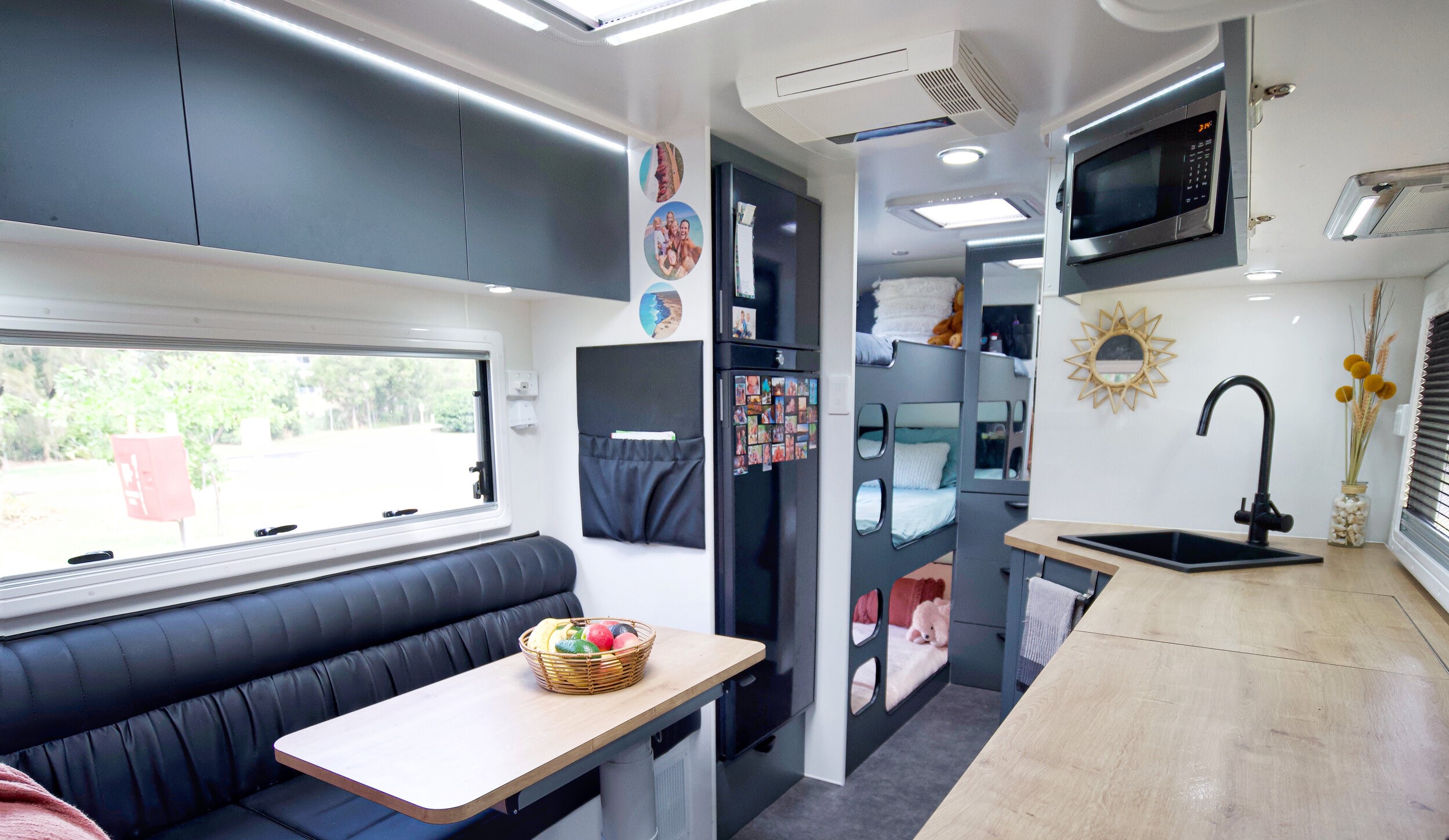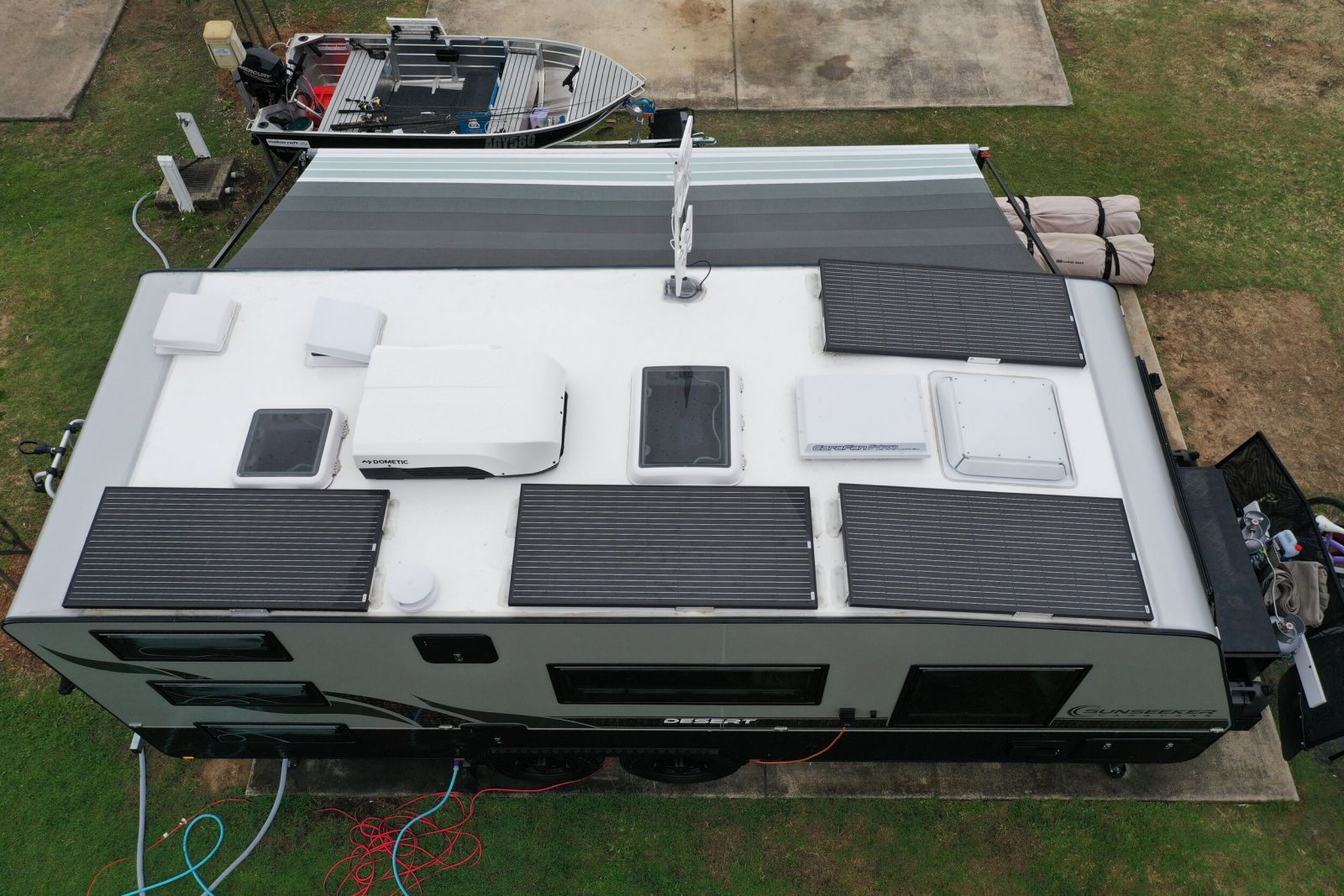Wondering how much power your caravan appliances actually use? You're not alone. Whether you're planning a lap around Australia or gearing up for a long weekend away, understanding the power draw of your appliances is crucial to setting up a reliable off-grid setup.
Maybe you're trying to decide if your battery can handle a rooftop air conditioner, or whether your solar panel setup will keep your fridge running all weekend. From toasters and kettles to washing machines and TVs, this guide breaks down real-world power consumption figures for common caravan appliances—so you can travel with confidence.
Whether you're upgrading your 12V setup or just starting out, this guide has the practical info you need to power your adventures—without blowing your budget.
Majority of the examples throughout this blog is based on a video made by our friends from Trip In A Van. Before you continue reading please watch the video below:
How to Work Out the Power Draw of Your Caravan Appliances
12V Appliances – Check the Amp Hour Ratings
For 12V appliances like fridges and water pumps, you can usually find the power draw in the product specifications. Look for the "average amp hour (Ah)" rating.
Example: The Dometic NRX115C fridge is listed as drawing about 1.27Ah per hour. Over 24 hours, that adds up to around 30Ah per day.
Note: This is based on factory testing in 25°C ambient temperature. In hotter conditions or different fridge settings, your power draw may increase.
Real-Life vs Factory Testing
The manufacturer at Dometic has tested a fridge in an ambient temperature (outside temperature) of 25°C. The fridge on average draws 1.2Ah per hour.
As your fridge runs for 24 hours, the above power draw equals 1.2 * 24 = 28.8Ah
Therefore, this fridge on average draws 28.8Ah per day.
It is important to note the difference between factory testing and real-world testing. It would be nice if the ambient temperature was 25 degrees every single day, but we know that the temperature can soar above 40 degrees in summer. And I don't know about you but I would like the beers cooled down to below 5 degrees.
Trip In A Van found that their CRX110 fridge actually drew around 1.95Ah on average and up to 4.5Ah in some conditions. This shows how real-world factors like temperature can impact power consumption.
240V Appliances – Convert Watts to Amps
240V appliances (like coffee machines and kettles) need to run through an inverter connected to your battery.
To calculate the current draw:
Watts ÷ Volts = Amps
Example: A 1300W coffee pod machine on a 12V battery: 1300W ÷ 12V = 108 Amps
Trip In A Van tested their pod machine and found it peaked at 90A, then quickly dropped to 13A once the water heated up.
What’s the Difference Between Amps and Amp Hours (Ah)?
-
Amps (A): The rate of current draw.
-
Amp Hours (Ah): How many amps are used over time.
Example: A fridge that uses 2A for 1 hour = 2Ah. If it runs all day, 2A x 24 = 48Ah/day.
Understanding this helps you calculate your total daily power usage.
Popular Caravan Appliances and Their Average Power Usage
Trip In A Van Appliance Testing Table
| Appliance: | Amps: | Hours Run Per Day: | Average Daily Consumption: |
|---|---|---|---|
|
CRX110 Fridge |
2A |
24 |
48 Ah |
|
Dometic RUC 8408X Compressor Fridge & Freezer 224L |
4A |
24 |
96 Ah |
|
Washing Machine |
7-15A |
15-30 minutes |
8 Ah |
|
750W Toasted Sandwich Maker |
40A |
5 minutes |
4 Ah |
|
Toaster |
45A |
5 minutes |
4 Ah |
|
2000W Induction Cooker |
Max 100A |
30 minutes |
50 Ah |
|
Coffee Pod Machine |
Up to 90A |
5 minutes |
8 Ah |
|
Milk Frother |
25A |
2 minutes |
1 Ah |
|
Microwave |
93A |
5 Minutes |
8 Ah |
|
Kettle |
147A |
5 minutes |
12 Ah |
|
12V Water Pump |
6A |
1 hour |
6 Ah |
|
Rooftop Air Conditioner |
50 – 60A |
Up to 3 hours |
55 Ah |
|
Other Combined Loads |
3A |
24 |
72 Ah |
Please note the CRX110 fridge was tested in a canopy off a battery.
How to Read the Table
-
Multiply the amps by the number of hours (or minutes converted to hours) to get daily amp hours.
-
Example: Microwave = 93A x (5/60) = 7.75Ah
Adding up everything in the table, you’d use about 319Ah/day – but it’s unlikely you’ll run every appliance every day.
Use our helpful solar calculator to input your specific appliances and usage for more accurate planning.
Why You Need a Battery Monitor
To keep track of power going in and out of your system, we recommend installing a battery monitor.
Top Pick: The Simarine Battery Monitor helps you:
-
See real-time power usage
-
Monitor charge levels
-
Prevent running your battery flat
Solar Input vs Power Output – Can You Keep Up?
Trip In A Van uses:
-
720W rooftop solar producing about 30A/hour in full sun (4.5 hours/day = 140Ah)
-
Enerdrive 40A DC to DC Charger adding 40A/hour while driving
Total input per day: up to 180Ah
This shows why matching your solar and charging to your power needs is so important.
How Much Power Does a Caravan Rooftop Air Conditioner Use?
Caravan Air Conditioners are 240V appliances. To calculate power draw you will need to find 240V AC input in watts or amps. This is not to be confused with the cooling capacity or AC output, for example the Dometic Freshjet 7 Series Plus has a maximum power consumption of 1748 Watts. When powering your air conditioner from an inverter off a battery, you need to calculate the current over 12 Volt (assuming your system is 12V).
1748W / 12V ≈ 145A
1748W drawing form 12V ≈ 145A
Therefore, this air conditioner theoretically draws 145A from a 12V system, on full power and the coldest setting.
The Trip In A Van real-world testing has uncovered some fascinating revelations about the power draw of the Dometic Harrier Plus. The new Dometic Freshjet 7 Series Plus also has a similar current draw when run from a 12V battery system via an inverter.
The air conditioner only pulled between 55Amps from their 12V lithium caravan battery setup. One reason for this would be the lithium battery is above 13V which will lower the current. But that will only account for about 20Amps. We do not really know why this air conditioner is drawing such a low current from this system, but it is likely due to the inverter technology within the Dometic air conditioner keeping it as efficient as possible. We have seen plenty of examples of this in other installations and on the workbench at Enerdrive.
To run a standard caravan air conditioner we would recommend starting with the following:
-
Minimum 200Ah lithium battery
-
2000W to 2600W inverter
Best Caravan Power Systems for High-Draw Appliances
To run air conditioners and other 240V appliances, these bundles are ideal:
In Trip In A Van's caravan featured in the video in this blog they were using the Enerdrive Pro Series 400Ah with 3000W Inverter Charger (now discontinued and updated).
Do You Need an Inverter in Your Caravan?
Yes, if you want to run any 240V appliances (like kettles or microwaves) off-grid, you need an inverter.
Remember to match the inverter size (watts) to the appliance requirements for safe and reliable operation.
How Much Solar Do You Need on Your Caravan?
Solar is super important and helps keep your batteries charged, especially off-grid.
Tips:
-
Fit as much solar as you can on the roof
-
Add a portable solar panel for extra flexibility if needed
-
Solar is one of the most affordable upgrades for long-term power so invest from the start
Learn more about solar systems for your caravan with our in depth guide, read it here!
Other Popular Appliances
Here are more common appliances and their average 12V power draw:
|
Appliance: |
Amp Hours: |
|
Laptop Charger |
4A |
|
Phone Charger |
0.5A |
|
Tablet Charger |
1A |
|
12V Fan |
3.5A |
|
12V Television (Small) |
6A |
|
12V Television (Large) |
10A |
Off-Grid vs Generator Power – Which is Best?
For some, using an inverter generator is still the simplest way to power high-draw 240V appliances. This is due to the portability and lower price point. For example you can still purchase a generator for under $900 that can run a kettle, toaster, or AC.
But for semi or full off-grid, a 100–200Ah lithium battery with solar and a charger bundle is often a better long-term solution.
Planning your caravan power setup doesn’t have to be overwhelming. With a clear understanding of how much power your appliances draw and how to match that with the right battery, inverter, and solar system, you’ll enjoy reliable off-grid power wherever your travels take you. Whether you're running the essentials or powering high-draw appliances like air conditioners, taking the time to plan ahead means fewer surprises on the road. If you're unsure where to start or want expert advice, our team is always here to help—just give us a call on 1800 787 278 or reach out via live chat.
DISCLAIMER* Please note, this advice is general in nature and we strongly recommend consulting the product manual and where relevant, a professional installer.
Comments (4)
Roof top A/c
Your calculations need a second look. I tested my Ibus 4 and was staggered to find that the longer it operated the less energy it took. All my testing was done via a power meter and a drop watch. My results were “ball park” with yours. The best indicator of real energy consumption I’ve seen . Well done. I have Enerdrive 3kW inverter 600Ah storage and 700W solar.By: Graham Tonkin on 09 November 2023
www.caravanrvcamping.com.au Response
Hi Graham, we are always interested in what customers Air Con's draw on their 12v systems. We would love it if you can send us a short clip or images of your read outs and when they were taken. You can email them direct to sales@caravanrvcamping.com.au
Power systems off grid
In my new Scorpion Sting JB van I'm getting an ecoflow lithium system 5kwh. solar 4x 200 3600w inverter. Will this run a Dometic ibis 4 off grid- and my fridge? Or how long will it run if I have sunny weather?By: Trish O'neil on 11 May 2023
www.caravanrvcamping.com.au Response
Hi Trish, you would be best to contact Ecoflow direct to source advice from them in terms of the ability to run an Air Con with its max draws etc
Set up of a battery system
Buying a new van - what would be an adequate set up for off - grid living.By: tony scott on 28 March 2023
www.caravanrvcamping.com.au Response
Hi Tony. Thanks for reaching out. We have sent you an email to discuss your needs further. Please refer to your email







